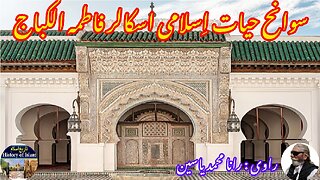Premium Only Content

Crises in Mamluk and restoration of state power | مملوک میں بحران اور ریاستی اقتدار کی بحالی
@islamichistory813 #Governance #CrisisResponse #ShaykhAnalysis #Crises #restoration #statepowerbyShaykh
Crises and restoration of state power by Shaykh
Dekhti Aankhooon aur sountay kaanoon ko Asslamoalaikum, sisters, brothers friends and elders, This video presents a thorough exploration of the themes surrounding crises and the restoration of state power, as discussed by Shaykh. We will analyze the critical moments when state authority is challenged and the strategies employed to reclaim stability and governance. Viewers will gain a deeper understanding of the complexities involved in state restoration and the implications for society at large.
Barquq died in 1399 and was succeeded by his eleven-year-old son, an-Nasir Faraj. That year, Timur invaded Syria, sacking Aleppo and Damascus. Timur ended his occupation of Syria in 1402 to fight the Ottomans in Anatolia, whom he deemed a more dangerous threat. Faraj held onto power during this turbulent period, which, in addition to Timur's devastating raids, the rise of Turkmen tribes in the Jazira, and attempts by Barquq's emirs to topple Faraj, also saw a famine in Egypt in 1403, a severe plague in 1405 and a Bedouin revolt that practically ended Mamluk control of Upper Egypt between 1401 and 1413. Mamluk authority throughout the sultanate significantly eroded, while the capital Cairo underwent an economic crisis.
Faraj was toppled in 1412 by the Syria-based emirs, Tanam, Jakam, Nawruz and al-Mu'ayyad Shaykh, against whom Faraj had sent seven military expeditions. The emirs could not usurp the throne themselves, and had Caliph al-Musta'in installed as a puppet sultan; the caliph had the support of the non-Circassian mamluks and legitimacy with the local population. Six months later, Shakyh ousted al-Musta'in after neutralizing his main rival, Nawruz, and assumed the sultanate.[116] Shaykh's main policy was restoring state authority within the empire, which experienced further plagues in 1415–1417 and 1420. Shaykh replenished the treasury through tax collection expeditions akin to raids across the empire to compensate the tax arrears that accumlated under Faraj. Shaykh also commissioned and led military campaigns against the Mamluks' enemies in Anatolia, reasserting the state's influence there.
Before Shaykh died in 1421, he attempted to offset the power of the Circassians by importing Turkish mamluks and installing a Turk as atabeg al-asakir to serve as regent for his infant son Ahmad. After his death, a Circassian emir, Tatar, married Shaykh's widow, ousted the atabeg al-asakir and assumed power. Tatar died three months into his reign and was succeeded by Barsbay, another Circassian emir of Barquq, in 1422. Under Barsbay, the Mamluk Sultanate reached its greatest territorial extent and was militarily dominant throughout the region, but his legacy was mixed in the eyes of contemporary commentators who criticized his fiscal methods and economic policies.
Barsbay pursued an economic policy of establishing state monopolies over the lucrative trade with Europe, particularly spices, at the expense of local merchants. European merchants were forced to buy spices from state agents who set prices that maximized revenue rather than promoting competition. This monopoly set a precedent for his successors, some of whom established monopolies over other goods such as sugar and textiles. Barsbay compelled Red Sea traders to offload their goods at the Mamluk-held Hejazi port of Jeddah rather than the Yemeni port of Aden to derive the greatest financial gain from the Red Sea transit route to Europe. Barsbay's efforts at monopolization and trade protection were meant to offset the severe financial losses of the agricultural sector due to the frequent recurring plagues that took a heavy toll on the farmers. In the long term, the monopoly over the spice trade had a negative effect on Egyptian commerce and became a motivation for European merchants to seek alternative routes to the east around Africa and across the Atlantic.
Barsbay undertook efforts protect the caravan routes to the Hejaz from Bedouin raids. He reduced the independence of the Sharifs of Mecca to a minimum, sent troops to occupy the Hejaz and rein in the Bedouin, and took direct control of much of the region's administration. He aimed to secure the Egyptian Mediterranean coast from Catalan and Genoese piracy. Related to this, he launched campaigns against Cyprus in 1425–1426, during which the island's Lusignan king, Janus, was taken captive, because of his alleged assistance to the pirates; the large ransoms paid to the Mamluks by the Cypriots allowed them to mint new gold coinage for the first time since the 14th century. Janus became Barsbay's vassal, an arrangement enforced on his successors for several decades after.
In response to Aq Qoyonlu raids against the Jazira, the Mamluks launched expeditions against them, sacking Edessa and massacring its Muslim inhabitants in 1429 and attacking their capital Amid in 1433. The Aq Qoyonlu consequently recognized Mamluk suzerainty. While the Mamluks succeeded in forcing the Anatolian beyliks to largely submit to their suzerainty, Mamluk authority in Upper Egypt was mostly relegated to the emirs of the Hawwara tribe. The latter had grown wealthy from their burgeoning trade with central Africa and achieved a degree of local popularity due to their piety, education and generally benign treatment of the inhabitants.
Tomorow we will be described Successors of Barsbay Mamluk. So permission us upto tomorow. Allah Hafiz
===============================
-
 7:57
7:57
ISLAMIC HISTORY
12 hours agoIslamic Women Scholar Fatima Al-Kabbaj फातिमा अल-कब्बाज فاطمہ الکباج کی سوانح حیات
5 -
 2:43:30
2:43:30
TimcastIRL
5 hours agoSouth Park Goes FULL CHARLIE KIRK, Latest Episode ROASTS Trump Again | Timcast IRL
200K73 -
 LIVE
LIVE
SpartakusLIVE
5 hours agoThe Return of the KING of Content
525 watching -
 10:05
10:05
MattMorseTV
8 hours ago $5.71 earnedHe actually did it...
46.1K18 -
 1:32:39
1:32:39
Anthony Rogers
1 day agoEpisode 376 - Todd Schowalter
19.7K -
 3:42:07
3:42:07
megimu32
4 hours agoOTS: Movie Tie-In Games + Remakes: Let’s Play Memory Lane
29.9K5 -
 1:15:06
1:15:06
Adam Does Movies
12 hours ago $0.79 earnedTalking Movies + Ask Me Anything - LIVE
22K -
 1:17:18
1:17:18
Glenn Greenwald
1 day agoWhat are CBS News' Billionaire Heirs Doing with Bari Weiss? With Ryan Grim on the Funding Behind It; Europe Capitulates to Trump Again | SYSTEM UPDATE #494
108K82 -
 1:43:49
1:43:49
RiftTV
6 hours agoCNN Calls Black NY Shooter WHITE, Cincinnati FATIGUE | The Rift | Guest: Braeden Sorbo, 2Protects1
49.6K14 -
 4:21:04
4:21:04
LumpyPotatoX2
7 hours agoKilling Floor 3: Rampage & Chaos - #RumbleGaming
17.2K